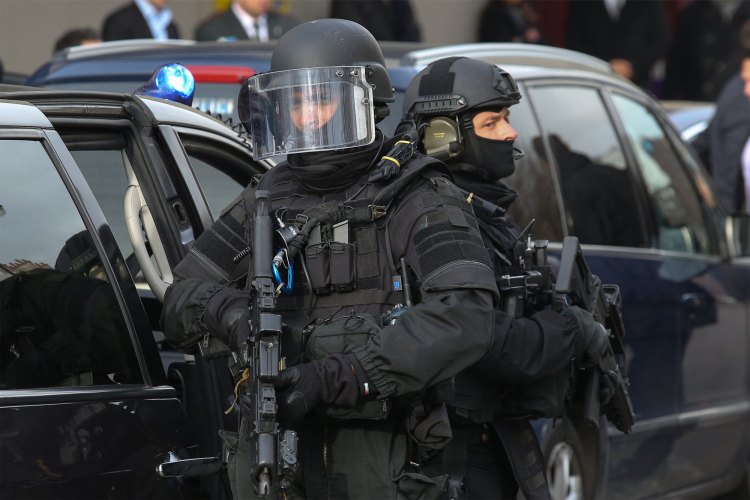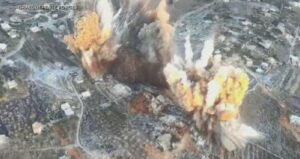Editor’s Note: As we roll up on the anniversary of the most despicable act of terrorism on American soil, I figured we would revisit some international organizations dedicated to taking on these bad actors. When it comes to counterterrorism, France has their act together, as evidenced by the relatively incident-free Paris Olympics. — GDM
In the United States, when metropolitan police encounter a violent situation that is a little “too rich for their blood,” Special Weapons And Tactics (SWAT) teams may be called upon to neutralize a threat. We readily recognize their profile: black uniforms and kit, black vehicles, armed to the teeth, and an aggressive demeanor. Should a hostage situation present itself, perhaps then it is a job for the FBI’s Hostage Rescue Teams (HRT).
I won’t pulverize the organizations or jurisdictional job responsibilities any further than that—just a cursory mention to draw attention to the French version of our U.S. law enforcement. My focus is on the recent torrent of terror in Paris, France.
Three Parisian units were called in to respond to the attackers: BRI, GIGN, and RAID. BRI and RAID are urban police units that fall under the French Ministry of the Interior (Ministere de l’Interieur). GIGN falls under the National Gendarmerie, or essentially the National Guard. BRI focuses on counterterrorism exclusive to Paris, RAID’s charter is counterterrorism on a national scale, and GIGN’s mission is worldwide counterterrorism.
The Brigade de Recherche et d’Intervention (BRI)
I present first the BRI, the Brigade de Recherche et d’Intervention, or Research and Intervention Brigade (RIB, ha ha). Their most likely American counterpart is a municipal Special Weapons And Tactics (SWAT) team. BRI is bestowed with powers of intervention and general authority as police officers. That means they have authority within their charter to invade with force the scene of a kidnapping or hostage rescue, and they have arrest authority. Powers under their charter include (but are unlikely limited to):
Resolution of hostage situations by peaceful or belligerent means
Armed intervention
Surveillance and stakeout operations
Anti-gang operations
Response to felony offenses
Maintaining criminal archives
BRI can work in conjunction with RAID in joint operations where mutual assistance is desired. BRI participation was invoked in response to the attack on the Parisian Charlie Hebdo periodical office, as were RAID and the vaunted GIGN. It is noteworthy to reiterate that BRI is exclusive to Paris, and remains solely within the Paris city limits.
Since I brought up the subject, I have been asked on more than just one occasion what Hebdo means. Clearly it is not a French word, so what is the origin? I can divulge that Hebdo is in fact a truncated form of the French word Hebdomidaire, which means ‘weekly’—mystery solved!
Editor’s Note: As we roll up on the anniversary of the most despicable act of terrorism on American soil, I figured we would revisit some international organizations dedicated to taking on these bad actors. When it comes to counterterrorism, France has their act together, as evidenced by the relatively incident-free Paris Olympics. — GDM
In the United States, when metropolitan police encounter a violent situation that is a little “too rich for their blood,” Special Weapons And Tactics (SWAT) teams may be called upon to neutralize a threat. We readily recognize their profile: black uniforms and kit, black vehicles, armed to the teeth, and an aggressive demeanor. Should a hostage situation present itself, perhaps then it is a job for the FBI’s Hostage Rescue Teams (HRT).
I won’t pulverize the organizations or jurisdictional job responsibilities any further than that—just a cursory mention to draw attention to the French version of our U.S. law enforcement. My focus is on the recent torrent of terror in Paris, France.
Three Parisian units were called in to respond to the attackers: BRI, GIGN, and RAID. BRI and RAID are urban police units that fall under the French Ministry of the Interior (Ministere de l’Interieur). GIGN falls under the National Gendarmerie, or essentially the National Guard. BRI focuses on counterterrorism exclusive to Paris, RAID’s charter is counterterrorism on a national scale, and GIGN’s mission is worldwide counterterrorism.
The Brigade de Recherche et d’Intervention (BRI)
I present first the BRI, the Brigade de Recherche et d’Intervention, or Research and Intervention Brigade (RIB, ha ha). Their most likely American counterpart is a municipal Special Weapons And Tactics (SWAT) team. BRI is bestowed with powers of intervention and general authority as police officers. That means they have authority within their charter to invade with force the scene of a kidnapping or hostage rescue, and they have arrest authority. Powers under their charter include (but are unlikely limited to):
Resolution of hostage situations by peaceful or belligerent means
Armed intervention
Surveillance and stakeout operations
Anti-gang operations
Response to felony offenses
Maintaining criminal archives
BRI can work in conjunction with RAID in joint operations where mutual assistance is desired. BRI participation was invoked in response to the attack on the Parisian Charlie Hebdo periodical office, as were RAID and the vaunted GIGN. It is noteworthy to reiterate that BRI is exclusive to Paris, and remains solely within the Paris city limits.
Since I brought up the subject, I have been asked on more than just one occasion what Hebdo means. Clearly it is not a French word, so what is the origin? I can divulge that Hebdo is in fact a truncated form of the French word Hebdomidaire, which means ‘weekly’—mystery solved!
Recherche, Assistance, Intervention, Dissuasion (RAID)
France fancies RAID, its primary national counterterrorist force, endowing it with a hefty arsenal of weapons and capabilities. Recent responses by RAID include the Charlie Hebdo assault and the Bataclan Theater massacres in Paris, France, this very year.
Within the RAID charter lies the following missions:
Nationwide counterterrorism
Hostage crisis response
Civil uprising response
Abduction and arrest of felony or high-profile criminals
RAID powers are supplemented by support subdivisions that engage in technical intelligence gathering, intelligence analysis, and tactical weaponry. Among numerous specialty areas that supplement the group are:
Close-quarters combat/battle (CQC/CQB)
Precision long-gun support
Technical explosives attack and disposal teams
Attack-dog handlers
Hostage-crisis negotiators
A broader departure from the capabilities of the Parisian BRI is RAID’s specialized means of infiltration capability, including airborne high/low altitude and waterborne, both surface and subsurface. An American equivalent force could well be the FBI’s Hostage Rescue Teams (HRT).
Groupe d’Intervention de la Gendarmerie National (GIGN)
The GIGN also responded to the two recent terrorist attacks in Paris. This group is part of the French military, and their closest American counterpart is the U.S. Army’s 1st Special Forces Operational Detachment-D, the Delta Force.
Much like Delta in the U.S., GIGN is tasked with counterterrorism and hostage rescue missions in France or anywhere in the world. Some of the GIGN’s most famous exploits include the December 1994 liberation of 229 passengers and crew from Air France Flight 8969 in Marseille.
An aspect that renders the GIGN and Delta the best match is that both of the units dare to engage in one of the most dangerous and complicated hostage situations—taking down a hijacked airliner. Both units routinely exercise numerous aircraft scenarios, constantly updating techniques to stay relevant to the ever-changing airline industry.
Within the GIGN charter lie the following tasks and authorizations:
Precision weapons capabilities
Specialized infiltration techniques: land, sea, air
Weaponless martial arts (hand-to-hand combat)
Clandestine surveillance
SERE: survival, escape, evade, and resist training
Precision explosives implementation and disposal (EOD)
Harsh climate warfare: tropics, desert, arctic, and mountains
Negotiation and diplomacy
My only experience with any of these three French maneuver entities has been with GIGN in the Balkan theater. While there was no joint operational climate, I did have ample opportunity to mix it up with the French troops there. They were immediately amused by my Louisiana-French/Cajun accent, and there were words to the effect of, “Ah yes, we have heard about you people.” I’d never been “you people” before….
I found them to be fundamentally no different than me: Many came from small towns and poor families, and most were athletic and staunchly patriotic. They were not quite as well funded as we Americans, but their kit was sensible and functional, and they were deadly. I met with them on two occasions, which afforded me another opportunity to correct their French. How does the saying go? Cut from the same piece of cloth? I know they are mixing it up hard with Daesh these days. I worry about them but think of them proudly and with confidence.
Vive la France. Geo sends.
—
Disclaimer: SOFREP utilizes AI for image generation and article research. Occasionally, it’s like handing a chimpanzee the keys to your liquor cabinet. It’s not always perfect and if a mistake is made, we own up to it full stop. In a world where information comes at us in tidal waves, it is an important tool that helps us sift through the brass for live rounds.



